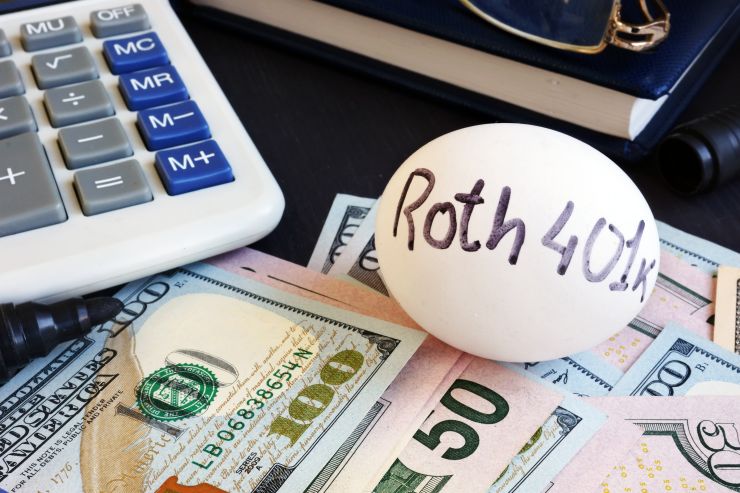
Investors hear a lot about the importance of diversifying their retirement portfolio.
Having the right mix of small and large caps, U.S., international, bond and alternative investments is critical to your long-term success.
But what about tax diversification? This can be just as important as what kinds of stocks, bonds and mutual funds you own.
Most Americans have the bulk of their retirement savings in a 401(k) plan or similar employer-sponsored retirement account, and that’s great.
Contributions to a 401(k) plan can reduce your taxable income today. But eventually, when you take distributions from the account, you’re going to owe ordinary income taxes.
More and more employers are offering another option for your retirement savings: a Roth 401(k).
A tax-free tomorrow
When you contribute to a Roth 401(k), the contribution won’t lower your taxable income today. But when you eventually take the money out, similar to a Roth IRA, it’s completely and utterly tax-free.
A Roth 401(k) allows you to save significantly more than a Roth IRA.
You can only contribute $6,000 to a Roth IRA for the tax year 2019. If you’re age 50 or older, you can save an additional catch-up contribution of $1,000.
The 401(k) plan world is more liberal with what you can save: up to $19,000 a year to a 401(k) in 2019, and Roth 401(k) plans share that limit. If you are over age 50, you can save an additional $6,000.
How much money you earn also makes a difference.
Roth IRAs have an income cap. You can’t contribute to a Roth IRA in 2019 if you earn more than $203,000. If you earn that much, say goodbye to this kind of tax-free investing.
Unless, of course, you have a Roth 401(k).
There is no one perfect investment or retirement savings vehicle. Every investor has their own unique circumstances that have to be considered.
The biggest drawback to a Roth 401(k) is how contributions might impact your tax liabilities today.
Let’s say you earn $100,000 a year. If you save $19,000 to a traditional 401(k), your taxable income would be only $81,000. But if you make the same $19,000 contribution to a Roth 401(k), you’ll still have taxable income of $100,000.
That could take dollars out of your current spending bucket. However, for many investors, the positives outweigh the negatives.
There are no tax consequences when you take money out of a Roth 401(k) when you’re 59½ and you have met the five-year rule. If you need $20,000, take out the $20,000, and no taxes are due. If you take a similar distribution from a traditional 401(k) plan, the money you withdraw is subject to ordinary income tax.
Then there are the required minimum distributions. Roth 401(k) account owners have to take the RMD at age 70½. That’s not the case for Roth IRA owners. For that reason, it’s suggested that Roth 401(k) account owners roll their Roth 401(k) to a Roth IRA account before they turn 70½.
Whatever kind of 401(k) your employer offers, take advantage. Both the traditional and the Roth give you the opportunity to save painlessly through automatic payroll deductions, and both give you matching funds (assuming your employer offers them). Just know matching funds to a Roth 401(k) go to a traditional 401(k) account since those employer matching dollars and the earnings on them are taxable when they are distributed.
The Roth 401(k) plan is not an all-or-nothing kind of deal.
To that point, I have been splitting my contributions 50/50 since the Roth 401(k) was first available. It allows me to take advantage of the tax-free growth without giving up all the tax advantages of pre-tax savings.More than just taxes
If you’re hesitant because you don’t want to lose the tax benefit of a traditional 401(k) contribution, consider this: Your savings strategies should be about more than short-term tax reduction.
People typically look at this decision as one of paying taxes now or paying taxes later. However, it is more complicated than that for most people. What it really comes down to is a look at cash flow today versus cash flow in retirement.
Taxpayers need to separate contributions from earnings. The standard 401(k) provides a current tax break, which means the actual savings cost less. The Roth 401(k) is an after-tax contribution so it reduces your current cash flow by the taxes you have to pay on these dollars.
The thing that many people forget is that the earnings are the most important part of this analysis. If the earnings are taxable as they are in a traditional 401(k), that can be a really high cost when distributions are taken over time, years in the future, with tax rates we can’t predict today.
If you opt for the Roth 401(k), the earnings are never taxed. Not ever.
This is the best news and the biggest impact of Roth 401(k) plans. It is critical to really think about this: You may have earnings over 20 or 30 years and you will never pay taxes on these dollars.
That’s where the tax diversification comes in. Have a little bit of both kinds of accounts and you’ll have more planning possibilities when you need to withdraw money to support your retirement lifestyle.
The more options, the better.
If your employer doesn’t offer a Roth 401(k) yet, it’s time to call your benefits department to make the request. It’s not costly or complicated for the employer because they’re only amending an existing plan. And offering tax-free money to employees for retirement? That’s priceless.























